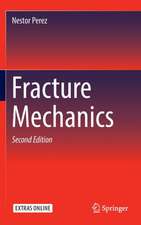Fracture Mechanics: Mechanical Engineering Series
Autor Dominique P. Miannayen Limba Engleză Hardback – 19 dec 1997
| Toate formatele și edițiile | Preț | Express |
|---|---|---|
| Paperback (1) | 643.48 lei 6-8 săpt. | |
| Springer – 12 noi 2012 | 643.48 lei 6-8 săpt. | |
| Hardback (1) | 649.71 lei 6-8 săpt. | |
| Springer – 19 dec 1997 | 649.71 lei 6-8 săpt. |
Din seria Mechanical Engineering Series
-
 Preț: 391.84 lei
Preț: 391.84 lei - 18%
 Preț: 1110.72 lei
Preț: 1110.72 lei - 15%
 Preț: 593.73 lei
Preț: 593.73 lei - 18%
 Preț: 944.99 lei
Preț: 944.99 lei - 15%
 Preț: 653.14 lei
Preț: 653.14 lei - 17%
 Preț: 363.13 lei
Preț: 363.13 lei - 18%
 Preț: 1239.05 lei
Preț: 1239.05 lei - 15%
 Preț: 640.06 lei
Preț: 640.06 lei - 18%
 Preț: 1129.65 lei
Preț: 1129.65 lei - 15%
 Preț: 522.24 lei
Preț: 522.24 lei - 15%
 Preț: 654.77 lei
Preț: 654.77 lei - 15%
 Preț: 643.34 lei
Preț: 643.34 lei - 15%
 Preț: 611.40 lei
Preț: 611.40 lei - 18%
 Preț: 765.96 lei
Preț: 765.96 lei - 20%
 Preț: 631.71 lei
Preț: 631.71 lei - 18%
 Preț: 1009.22 lei
Preț: 1009.22 lei -
 Preț: 418.34 lei
Preț: 418.34 lei - 15%
 Preț: 640.71 lei
Preț: 640.71 lei -
 Preț: 403.53 lei
Preț: 403.53 lei - 18%
 Preț: 813.97 lei
Preț: 813.97 lei - 18%
 Preț: 1386.48 lei
Preț: 1386.48 lei - 18%
 Preț: 951.47 lei
Preț: 951.47 lei - 18%
 Preț: 833.09 lei
Preț: 833.09 lei - 18%
 Preț: 936.60 lei
Preț: 936.60 lei - 15%
 Preț: 644.49 lei
Preț: 644.49 lei - 18%
 Preț: 941.05 lei
Preț: 941.05 lei - 18%
 Preț: 1386.17 lei
Preț: 1386.17 lei -
 Preț: 399.67 lei
Preț: 399.67 lei - 18%
 Preț: 1389.44 lei
Preț: 1389.44 lei - 18%
 Preț: 790.46 lei
Preț: 790.46 lei - 18%
 Preț: 1388.22 lei
Preț: 1388.22 lei - 18%
 Preț: 1024.53 lei
Preț: 1024.53 lei - 15%
 Preț: 590.16 lei
Preț: 590.16 lei - 18%
 Preț: 1234.00 lei
Preț: 1234.00 lei - 18%
 Preț: 1386.62 lei
Preț: 1386.62 lei - 15%
 Preț: 543.85 lei
Preț: 543.85 lei -
 Preț: 391.61 lei
Preț: 391.61 lei - 18%
 Preț: 944.19 lei
Preț: 944.19 lei - 18%
 Preț: 736.16 lei
Preț: 736.16 lei - 18%
 Preț: 943.88 lei
Preț: 943.88 lei - 15%
 Preț: 693.21 lei
Preț: 693.21 lei - 18%
 Preț: 781.77 lei
Preț: 781.77 lei - 15%
 Preț: 639.08 lei
Preț: 639.08 lei - 23%
 Preț: 737.29 lei
Preț: 737.29 lei - 15%
 Preț: 641.53 lei
Preț: 641.53 lei -
 Preț: 401.42 lei
Preț: 401.42 lei
Preț: 649.71 lei
Preț vechi: 764.37 lei
-15% Nou
Puncte Express: 975
Preț estimativ în valută:
124.33€ • 132.94$ • 103.66£
124.33€ • 132.94$ • 103.66£
Carte tipărită la comandă
Livrare economică 18 aprilie-02 mai
Preluare comenzi: 021 569.72.76
Specificații
ISBN-13: 9780387982427
ISBN-10: 0387982426
Pagini: 338
Ilustrații: XVIII, 338 p.
Dimensiuni: 155 x 235 x 24 mm
Greutate: 0.68 kg
Ediția:1998
Editura: Springer
Colecția Springer
Seria Mechanical Engineering Series
Locul publicării:New York, NY, United States
ISBN-10: 0387982426
Pagini: 338
Ilustrații: XVIII, 338 p.
Dimensiuni: 155 x 235 x 24 mm
Greutate: 0.68 kg
Ediția:1998
Editura: Springer
Colecția Springer
Seria Mechanical Engineering Series
Locul publicării:New York, NY, United States
Public țintă
ResearchCuprins
1 Microscopic aspects of fracture: Cohesive stress.- 2 Linear elastic behaviour of flaws: Purely elastic treatment.- 2.1 The notch: stress and strain concentrations.- 2.2 The crack: stress intensity factors.- 2.3 The three-dimensional crack.- 3 Linear elastic treatment of flaws: Plasticity correction.- 3.1 Model of small scale yielding for a notch.- 3.2 Models of small scale yielding for a crack.- 3.3 Implications of these models in fracture.- 4 Linear elastic treatment of fracture: The risk of brittle fracture.- 4.1 The toughness.- 4.2 The flaw.- 4.3 The mechanical loading.- 4.4 Example of application: Pressure vessels.- 5 Microscopic aspect of fracture: Cleavage and ductile rupture.- 5.1 Background of Dislocation Theory.- 5.2 Experimental modes of investigation.- 5.3 Cleavage fracture.- 5.4 Intergranular fracture.- 5.5 Ductile fracture.- 5.6 Shear fracture.- 5.7 The ductile-brittle transition with smooth and notched specimens.- 6 Plastic treatment of discontinuities: Fully plastic treatment and large deformation correction.- 6.1 Rigid-perfectly plastic material: The limit load.- 6.2 Strain hardening plastic material: The contour integral.- 6.3 The three-dimensional problem.- 6.4 Crack extension.- 6.5 Using the J integral in fatigue analysis.- 7 Plastic treatment of discontinuities: Elastic-plastic treatment.- 7.1 General description of stress and strain fields.- 7.2 The small-scale yielding and theQfamily of fields.- 7.3 Small Scale Yielding and mixed modes.- 7.4 Finite-width crack bodies.- 7.5 The loading parameters.- 7.6 The three-dimensional problem.- 7.7 The quasi-static growth.- 7.8 Implication of these models for fracture.- 8 Elastoplastic treatment of discontinuities: The risk of fracture.- 8.1 Toughness: Relationship between microscopic and macroscopic aspects.- 8.2 Structural applications.- Appendices.- Guide for Further Reading and Bibliography.- Answers to Selected Problems.
Caracteristici
Intended for engineers from a variety of disciplines that deal with structural materials - Describes the current state of knowledge of how fractures in materials form and propagate, leading to failure - Concludes with discussions of generalized plasticity and the link between the microscopic and macroscopic aspects














